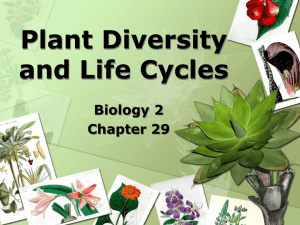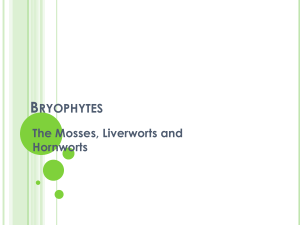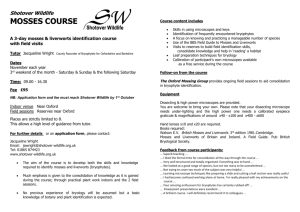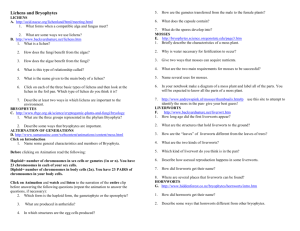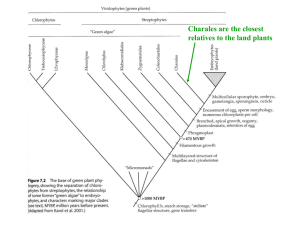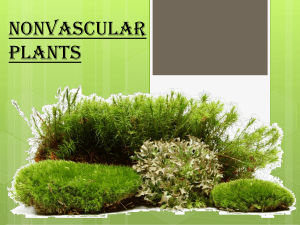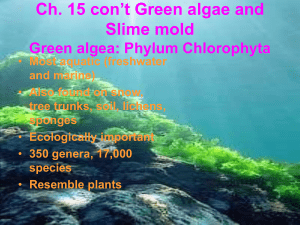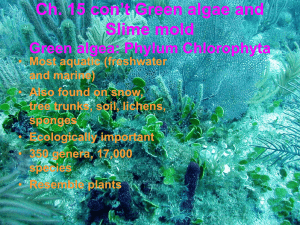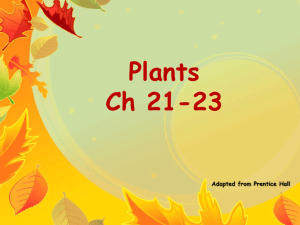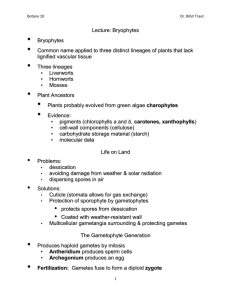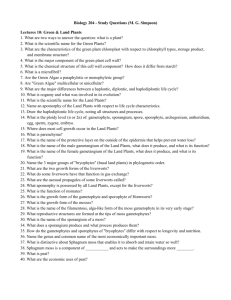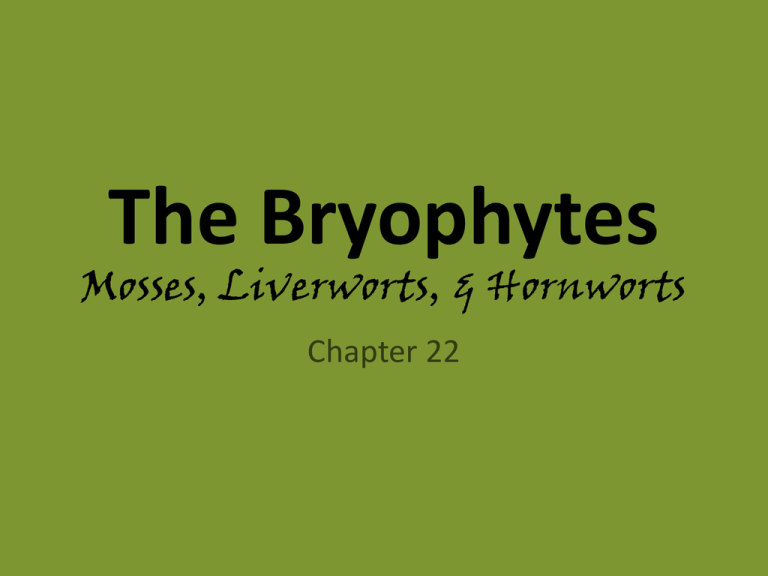
The Bryophytes
Mosses, Liverworts, & Hornworts
Chapter 22
Evolution of Land Plants
• Land plants evolved from
green algae
– Evidences:
• Share chemical & metabolic
traits
• Same photosynthetic
pigments
• Store excess carbohydrates as
starch
• Cellulose is a major
component of both cell walls
• The most direct ancestors
of plants are the
Charophytes “stoneworts”
Adaptations for Life on Land
• Cuticle
– Waxy covering over the
epidermis of aerial plant
parts
– Prevents desiccation “water
loss”
• Stomata
– Small pore in the plant
epidermis
– Allows gas exchange for
photosynthesis
The Plant Life Cycle
Alternation of Generations
• Haploid (gametophyte)
stage alternates with a
diploid (sporophyte) stage
in the life cycle
Plant Reproduction
• Gametangia – Plant sex
organs
– Consists of 2 parts:
• A protective outer layer of
sterile (non-reproductive) cells
• Gametes – sperm or egg cells.
• Male Gametangia =
Antheridium
– Bears numerous sperm cells
• Female Gametangia =
Archegonium
– Bears a single egg cell
Moss Gametangia
Antheridium – Male
Archegonium – Female
4 Main Groups of Plants
1.
Bryophytes – Nonvascular; spores
–
–
–
2.
Seedless vascular plants; spores
–
–
3.
Club Mosses
Ferns, whisk ferns, and horsetails
Gymnosperms; seeds
–
–
–
–
4.
Mosses
Stoneworts
Liverworts
Conifers
Cycads
Ginkgoes
Gnetophytes
Angiosperms “Flowering plants”; seeds
–
–
Monocots
Eudicots
Quiz!
• What is vascular tissue?
• What are the two types of tissue that make up
the vascular tissue system?
• What does each tissue do?
Bryophytes
• “moss plant”
• Nonvascular plants
– Cannot extensively transport
water, sugar, and minerals
– Rely on diffusion and
osmosis to obtain water and
dissolved nutrients
– Typically small
• Some have a cuticle
• Some absorb water directly
through leaf surfaces
• Most require moist
environments to reproduce
Bryphytes
• 3 Phyla of Bryophytes
1. Phylum Bryophyta: Mosses
2. Phylum Hepatophyta: Liverworts
3. Phylum Anthocerophyta: Hornworts
• All are Gametophyte dominant
– Spend most of their life cycle in the
gametophyte stage
Mosses
• Location: soil, rocks, tree bark
• Help form soil
• Colonize rocky sites that were previously colonized by
lichens
• Prevent soil erosion
– Grow packed together in dense colonies
• The Moss Body
– Thallus – Body structure
– Rhizoids – hair-like absorptive structures
• Do not have true roots, stems, or leaves
• Many mosses have separate sexes: male plants and
female plants
• The gametophyte generation is dominant
Lifecycle of Mosses: Read p. 435
A filament of
haploid cells that
grows from a spore
Bryophytes
Gametophyte Generation
Sporophyte Generation
Liverworts
• Thallus
– A body that lacks roots, stems,
or leaves
– Liverworts get their name from
their liver shaped thallus
• Gemmae
– Asexual reproductive structure
of liverworts
– Small balls of tissue
– Borne in a saucer-shaped
structure – gemmae cup
Hornworts
– Location: fields &
roadsides
– Thalloids - 1-2 cm
– Sporophyte generations
form hornlike
projections out of the
gametophyte thallus
Hornworts

